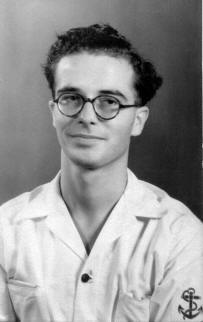









|
|

Alan Keech's Story
I was posted to Sharpshooter on 3/1/46 when she was in London
docks being fitted-out as a Survey Vessel. There was no
heating so I wore an overcoat, hat and scarf and typed with
gloves on. Not an auspicious start. However, the Ship’s
Office which had been a minesweeping storeroom (the
penultimate porthole on the port side) was not finished and
the carpenter asked me if I wanted a bunk-board fitted to my
desk. As a result I wound up with a “bed” approx 6' x 3'
whereas many of the crew were lucky to find somewhere to sling
their hammocks. The ship’s complement as a Survey Vessel
under independent command was around 50% higher than she was
designed for, so living accommodation was very tight and we
received “double hard-lying money” to compensate.
My job was
“Captains Writer” and I typed his correspondence in addition
to my normal range of duties, such as keeping the pay ledgers,
victualling accounts, Post Office Savings Bank records, etc.
The war records of
Sharpshooter and the other Halcyon’s were magnificent. As
well as minesweeping, they escorted conveys to Russia, in the
Atlantic and Mediterranean; rescued thousands of troops at
Dunkirk and the crews of many sunken RN and merchant vessels.
Sharpshooter even sunk a U-Boat! Her peacetime role was
entirely different. By comparison she became a “cruise
ship.” In 1946/47 she took five months to get to Singapore;
visiting Gibraltar, Port Said, Aden, Bombay, Colombo,
Trincomalee, Mergui (Burma), Penang, Kuantan (Malaya), Borneo,
Sarawak and many small towns and villages in the Far East.
The only enemies we saw were Japanese POW’s cleaning our
boilers in Singapore. The only danger we were in was when we
“closed all watertight doors and hatches” whilst entering
Mergui harbour which was mined. Whilst at sea off Kuantan we
did an asdic search for an obstruction, rumoured to be the
wreckage of “Prince of Wales” and “Repulse.” It turned out to
be an elaborate fish trap constructed from brushwood by local
fisherman.
On passage we swam
over the side in the Med; sunned ourselves on beaches in
Ceylon and Penang; watched the gold dome of the Mergui Pagoda
being polished every morning. In Bombay, I went ashore with
the Supply Officer to get local currency during serious
rioting. There was no transport so we walked through the
streets, past the dead and dying, carrying a heavy holdall
between us containing thousands of rupees. I had a gun but,
unbelievably, no bullets. Just as well, because I had never
used a revolver!
When surveying the
river Rajang in Sarawak we frequently looked like pirates. We
wore what we liked, shaved if we felt like it and became
almost as dark skinned as the local Dyaks. Some of us even
wore sarongs when sunbathing on the upper deck. Being away
from Singapore for weeks at a stretch with no mail deliveries
there was, at times, very little for me to do, so I
volunteered to go away in the survey launches, erecting tide
poles and “watching” them to record the rise and fall of water
for use on the charts being drawn-up on board. We were away
from the ship for up to twelve hours a day and the corned beef
curries at lunchtime were “memorable”. On ship I took turns
in the asdic cabin which also entailed recording the depths of
water.
On one occasion
“Doc” Reid (the LSBA) and I hired bikes and rode through the
jungle to a mission hall where I recall seeing portraits of
our King and Chiang Kai-shek hanging side by side. At that
time headhunters were still active and there were still
Japanese soldiers who did not know the war was over. With
that, and the potential danger from snakes and other animals,
I guess we were lucky the trip proved to be uneventful.
When we returned to
Singapore for stores, mail and repairs, etc., the ship had to
be cleaned up and I recall one occasion when I had volunteered
to “paint ship” we were joined by the First Lieutenant (Lt.
Cdr. G.S. Ritchie) with a chipping hammer and brush to show us
how it was done. On another occasion he put me on a charge
for being improperly dressed on the upper deck when the ship
was entering harbour. Lt. Cdr. G.S. Ritchie went on to
command four Survey Vessels, was promoted to Rear Admiral and
became Hydrographer of the Navy. His excellent account of the
ship’s time in the Far East is also on this web site.
I left the Navy before I “drew my
tot” but at times my job made me especially popular and I was
give “sippers.” Christmas 1946 was spent at anchor in
Singapore harbour. The wardroom was thrown open to all, the
booze flowed freely and I didn’t wake up until after
midnight
and then had to go looking for my Christmas dinner! It was an
extremely happy ship and many of us needed “sippers” or
“gulpers” when we left Sharpshooter for the last time.
Sharpshooter had a
long and illustrious career. She was a tough little ship
(only 830 tons) built in 1936 for around £100,000. What
excellent value! Speaking of value, how much would it cost
today for a similar Far Eastern “cruise”?
October 2006
|
|

